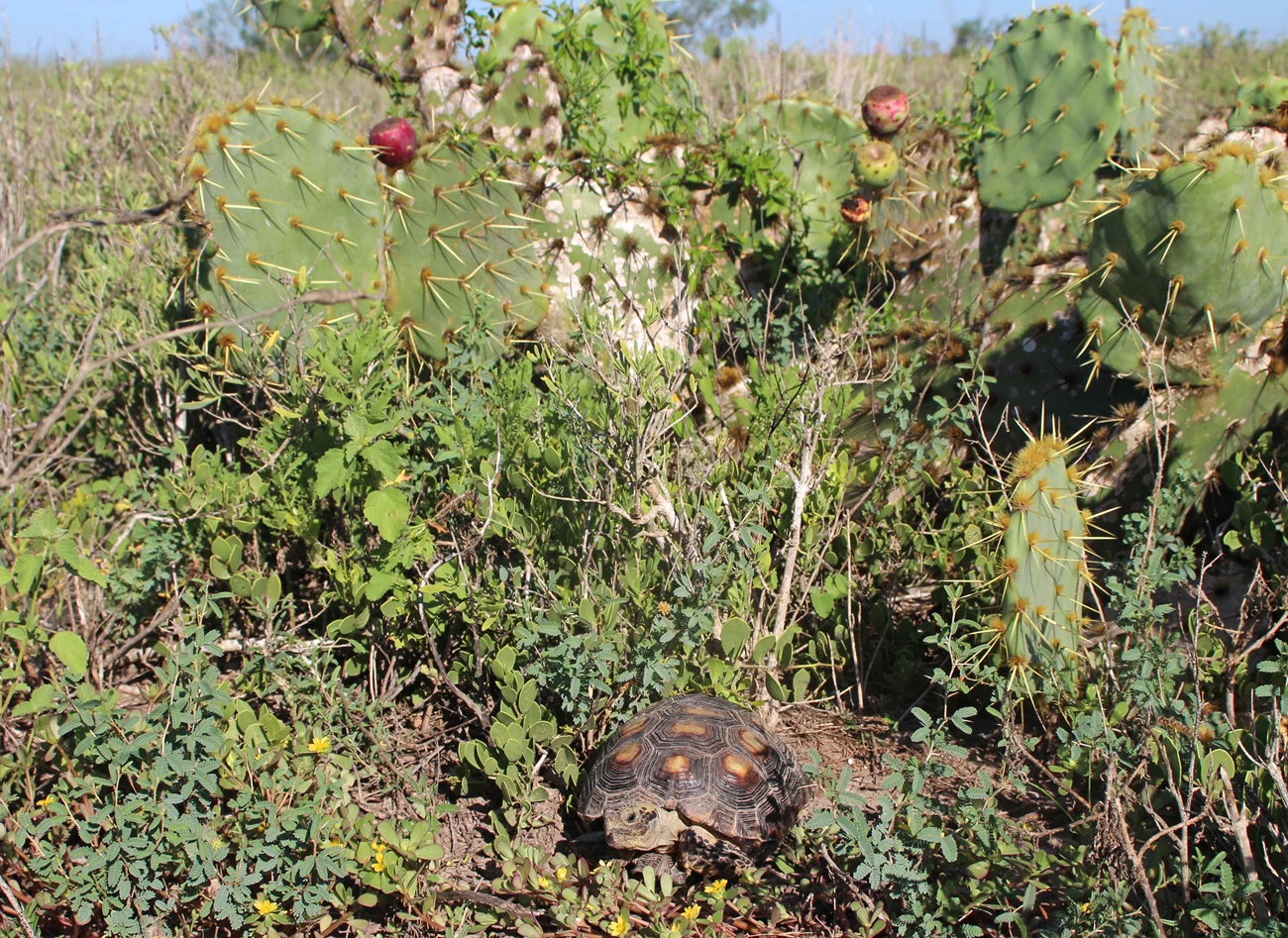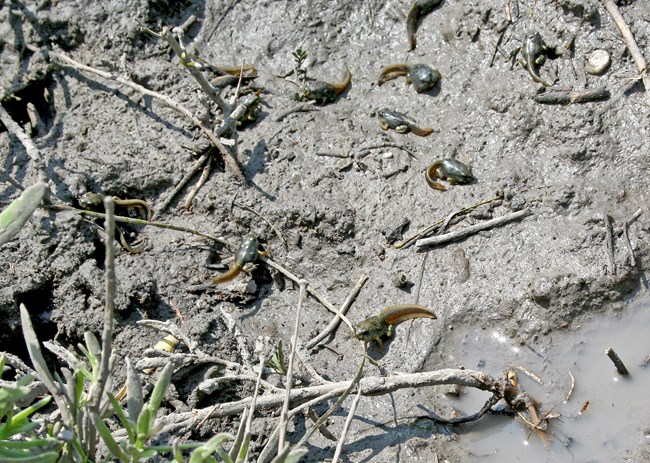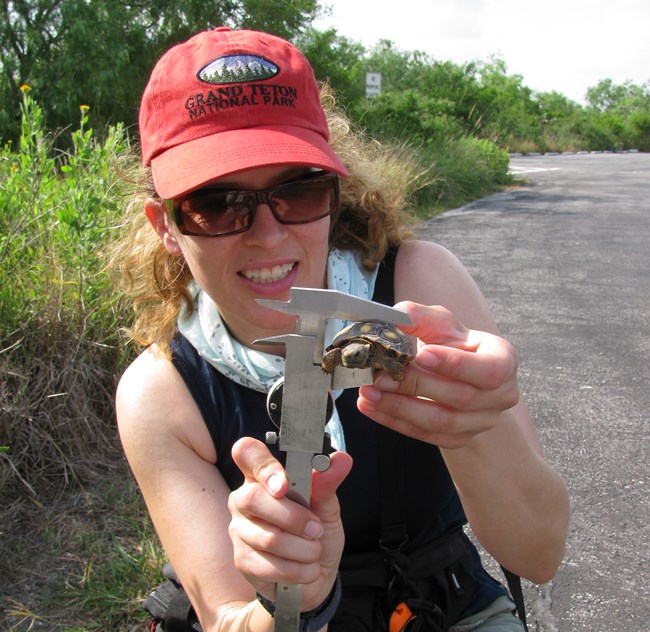
Billy Finney/NPS
Overview
Palo Alto Battlefield National Historical Park (PAAL) is located in the Matamoran district of the Tamaulipan biotic province on the Rio Grande delta plain. This area is a unique blend of northern, coastal, and tropical, and western desert characteristics. The park is located 16 kilometers (10 miles) north of the Rio Grande River in southern-most Texas and is also within 30 kilometers (18.6 miles) of the coast. Its function is to preserve the 1,376-hectare (3,400-acre) site of the first major battle of the U.S.–Mexican War (1846–1848). The climate is subtropical and semi-arid, and much of the park is only a few meters above sea level (elevation range of 3.0–6.4 meters or 9.7–20.9 feet). What elevational changes exist, however, are associated with marked changes in vegetation.
The park currently has two major management issues: non-native species and land-use impacts. Although high-salinity soils shielded portions of the park from intensive agriculture in the past, the area does show effects of previous land use. Vegetation has changed across the park due to brushland clearing; introducing non-native plants for grazing; and altering hydrology such that resacas (historic river channels, meanders and oxbows) are dry and sediment-filled, and flooding is unnaturally infrequent in the park. If Brownsville’s rapid growth rate continues, then the park setting will become increasingly urban, with increased habitat isolation and other management challenges.

Jane Carlson/NPS
Ecosystems at Palo Atlo Battlefield NHP
Three general habitat types or zones have been described in Palo Alto Battlefield NHP: a type of grassland called salt prairie, scrubland, and freshwater wetlands.
Salt-prairie habitat is the largest system on the park, covering over 50% of the park’s land area. Salt prairies occur in low-lying areas with poorly drained soils. The lowest elevations in this system support the cordgrass sacahuiste (Spartina spartinae) with some expanses of Borrichia or salt flats, which are characterized primarily by sea oxeye (Borrichia frutescens) and succulents among the bare patches of soil. The borrichia flats are mainly in natural depressions that were once frequently flooded but are now dry most of the year due to the historical creation of artificial ponds, called cattle tanks, and other disruptions to the park’s natural hydrology. At slightly higher elevations from the sacahuiste and borrichia flats, there is a transitional zone with short-statured, salt tolerant forbs and grasses (e.g., Borrichia frutescens, Batis maritima, Suaeda sp., Atriplex sp., Rayjacksonia phyllocephala, Prosopis reptans, Maytenus phyllanthoides, Monanthochloë littoralis, Pappophorum vaginatum) and abundant Engelmann’s prickly pear (Opuntia engelmannii). Collectively, these two ‘salt prairie’ vegetation types are presumed to have been the primary vegetation type in the commemorated battlefield when the battle took place in 1846.
Scrubland/brushland habitat covers less than a quarter of the park and exists primarily in the southwest corner, along its western side, and curving along the northern boundary. Scrubland occurs on the highest elevations of the park on what are called lomas, or historic natural levees, that are adjacent to former channels and oxbows of the Rio Grande. The lomas were created through sediment deposition along the banks of the historic waterways, which were eventually cut off from the river as it shifted naturally over time. With their higher elevations, the park’s lomas have better drainage and less saline soils than the surrounding salt prairie. Therefore, they support distinct vegetation communities comprised of thorny shrubs, cacti and small tree species. Some of park’s lomas were once cleared for cattle, allowed to regrow, and are now dominated by stands of honey mesquite (Prosopis glandulosa) with a grassy understory, now including the invasive Guineagrass (Urochloa maxima). Otherwise, the primary vegetation type on lomas is a dense and diverse assemblage of thorny shrubs called Tamaulipan thornscrub. Notable species in the thornscrub include honey mesquite, spiny hackberry (Celtis pallida),Texas ebony (Ebenopsis ebano), lotebush (Ziziphus obtusifolia), snake-eyes (Phaulothamnus spinescens), cat-claw acacia (Senegalia greggii), colima (Zanthoxylum fagara), huisache (Vachellia farnesiana), all thorn goatbush (Castela erecta), fiddlewood (Citharexylum berlandieri), brasil (Condalia hookerii), elbowbush (Foresteria angustifolia), Spanish dagger (Yucca treculeana), pencil cactus (Oputnia leptocaulis) and Engelmann’s prickly pear (Opuntia engelmannii). Vegetation elements from the salt prairie may be present in the understory, in addition to many other cactus, forb and grass species.

Joe Meiman/NPS
Wetlands compose approximately 2% of the park and consist primarily of resacas, i.e., abandoned channels, tributaries and oxbows of the Rio Grande, and human-made waterholes for cattle. Many resacas gradually filled with sediment from erosion and now support freshwater wetland species. During hurricanes or other storms, surface water travels through the park in sheets rather than streams or human-made ditches, which are common elsewhere in the Lower Rio Grande Valley. Because salt prairie dominated the area and row-crop agriculture was not successful, the park is generally free of scars caused by major irrigation and drainage ditches.
Species lists for the park are quite remarkable, especially given the park's small size. The Rio Grande Valley is a hotspot for birdwatching, with over 100 species recorded for the park itself. Notable species include the Apomodo falcon, Verdin, Greater Roadrunner, Olive Sparrow, Pyrrhuluoxia, Green Jay, and White-tipped Dove. Reptile diversity is also high on the park, ranging from massive western diamondback rattlesnakes (Crotalus atrox) and strikingly-long Texas Indigo snakes (Drymarchon corais) to smaller Texas horned lizards (Phrynosoma cornutum) and of course, the smallest North American tortoise, the Texas tortoise (Gopherus berlandieri). Several unique amphibian species occur on the park despite its limited freshwater, including black-spotted newts (Notophthalmus meridionalis), common Mexican treefrogs (Smilisca baudinii) and couch's spadefoot toads (Scaphiopus couchii). Finally, in addition to native mammals like the southern plains woodrat (Neotoma micropus), the park has two large mammals that are non-native: feral hogs (Sus scrofa) and the Indian Nilgai (Boselaphus tragocamelus).

Billy Finney/NPS (left), GULN/NPS (center and right).

GULN/NPS
Vital Signs Monitored at Palo Alto Battlefield NHP
The Gulf Coast Network monitors three indicators of ecological health—called vital signs — at this park. They are:Additional Resources
Source: NPS DataStore Saved Search 3719. To search for additional information, visit the NPS DataStore.

Jane Carlson/NPS
Last updated: January 8, 2026
